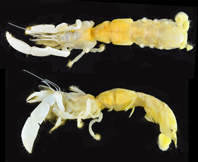Abstract
The Ryukyu Archipelago of Japan is a recognized global biodiversity hotspot with many endemic species. However, our knowledge of the termite fauna of the Ryukyu Archipelago is insufficient. Here, we report a new species of endemic drywood termite (Kalotermitidae) from the Ryukyu Archipelago. Our systematic study of the genus Neotermes (Isoptera: Kalotermitidae) from the Ryukyu–Taiwan Island arc using molecular and morphological methods found that N. koshunensis had also been composed of a second cryptic species, N. sugioi sp. nov. These two species are distributed allopatrically in the Ryukyu–Taiwan Island arc, with the former only in Taiwan and the latter only in the Ryukyu Archipelago. Our discovery of a new drywood termite species from the Ryukyu Archipelago suggests that both morphological and molecular assessments of the species now considered to be distributed widely in the Ryukyu–Taiwan Island arc are needed to clarify the termite fauna of the Ryukyu Archipelago. [Species Zoobank registration: http://zoobank.org/urn:lsid:zoobank.org:pub:E8C9693A-E24F-445D-8445-320564565964]
References
Azuma, S. & Kinjo, M. (1987) Check-list of the Insects of Okinawa. The Biological Society of Okinawa, Okinawa, 422 pp. [in Japanese]
Azuma, S., Yafuso, M., Kinjo, M., Hayashi, M., Kohama, T., Sasaki, T., Kimura, M. & Kawamura, F. (2002) Check list of the Insect of the Ryukyu Islands, Second Edition. The Biological Society of Okinawa, Okinawa, 570 pp. [in Japanese]
Belyaeva, N. & Dovgobrod, I. (2006) The genitalia of termites (Isoptera): possibilities of using in taxonomy. Entomological Review, 86, 501–508.
https://doi.org/10.1134/S0013873806050010
Eggleton, P. (2000) Global patterns of termite diversity. In: Abe, T., Bignell, D.E. & Higashi, M. (Eds.), Termites: Evolution, Sociality, Symbioses, Ecology. Kluwer Academic Publishers, Dordrecht, pp. 25–51.
https://doi.org/10.1007/978-94-017-3223-9_2
Hall, T.A. (1999) BioEdit: a user-friendly biological sequence alignement editor and analysis program for Windows 95/98/NT. Nucleic Acids Symposium Series, 41, 95–98.
Hatusima, S. (1980) Origin of the flora in the Ryukyu Islands. In: Kizaki, K. (Ed.), Natural History of the Ryukyus. Tsukiji-shokan, Tokyo, pp. 113–123. [in Japanese]
Huang, F.S., Zhu, S.M., Ping, Z.M., He, X.S., Li, G.X. & Gao, D.R. (2000) Fauna Sinica: Insecta. Vol. 17. Isoptera. Science Press, Beijing, 961 pp. [in Chinese]
Huang, Z., Chen, X., Shi, Y., Shen, Z., Peng, J. & Yang, H. (2011) Molecular analysis of some Chinese termites (Isoptera) based on the mitochondrial cytochrome oxidase (COII) gene. Sociobiology, 58, 107–118.
Ikehara, S. (1966) Distribution of termites in the Ryukyu archipelago. Bulletin of Arts & Science Division, University of the Ryukyus, Mathematics & Natural Sciences, 9, 49–178.
Krishna, K. (1970) Taxonomy, phylogeny and distribution of termites. In: Krishna, K. & Weesner, F.M. (Eds.), Biology of Termites. Vol 2. Academic Press, New York, pp. 127–152.
Krishna, K., Grimaldi, D.A., Krishna, V. & Engel, M.S. (2013) Treatise on the Isoptera of the world. Bulletin of the American Museum of Natural History, 377, 1–2704.
Li, H.F., Scheffrahn, R.H., Su, N.Y., Kanzaki, N. & Yang, R.L. (2008) Survey of the termites (Isoptera: Kalotermitidae, Rhinotermitidae, Termitidae) of Lanyu Island, Taiwan. Florida Entomologist, 91, 472–473.
https://doi.org/10.1653/0015-4040(2005)88[502:KTTFOC]2.0.CO;2
Maryańska-Nadachowska, A., Drosopoulos, S., Lachowska, D., Kajtoch, Ł. & Kuznetsova, V.G. (2010) Molecular phylogeny of the Mediterranean species of Philaenus (Hemiptera: Auchenorrhyncha: Aphrophoridae) using mitochondrial and nuclear DNA sequences. Systematic Entomology, 35, 318–328.
https://doi.org/10.1111/j.1365-3113.2009.00510.x
Morimoto, K. (1968) Termites of the genus Reticulitermes of Japan and Taiwan. Bulletin of the Government Forest Experiment Station, 217, 43–73.
Morimoto, K. (1980) Termites. In: Editorial Committee of Shiroari Shosetsu (Ed), Shiroari Shosetsu. The Japan Termite Control Association, Tokyo, pp. 1–111. [in Japanese]
Motokawa, M. (2000) Biogeography of living mammals in the Ryukyu Islands. Tropics, 10, 63–71.
https://doi.org/10.3759/tropics.10.63
Nylander, J.A.A. (2004) MrModeltest. Version 2. Evolutionary Biology Centre, Uppsala University, Uppsala. [program distributed by the author]

